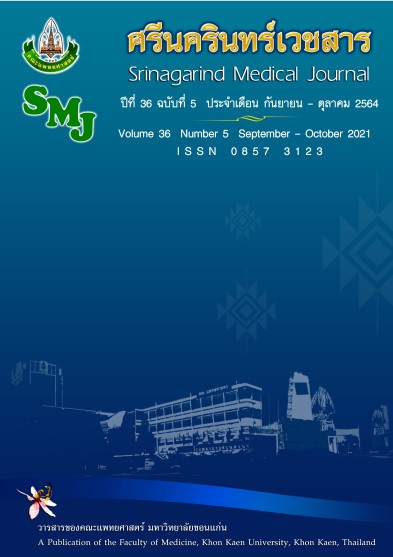การพยาบาลเพื่อป้องกันภาวะแทรกซ้อนผู้ป่วยบาดเจ็บกระดูกสันหลังและไขสันหลังในระยะฟื้นฟู
Abstract
Nursing Care for Prevention Complications of Patient with Spine and Spinal Cord Injuries in Rehabilitation Phase
Patcharee Butsankot*, Juthamas Kongklang
Nurse/ Spinal Unit, Surgical and Orthopedic division, Department of Nursing Siriraj, Siriraj Hospital.
*Corresponding author: Patcharee Butsankot, Nurse/ Spinal Unit, Surgical and Orthopedic division, Department of Nursing Siriraj, Siriraj Hospital. E-mail: noontmn.siriraj@gmailmail.com
บทคัดย่อ
การบาดเจ็บของกระดูกสันหลังและไขสันหลังเป็นการบาดเจ็บที่รุนแรง และทำให้เกิดความพิการ ในประเทศที่พัฒนาแล้วพบอุบัติการณ์การเกิดประมาณ 10.4–130.6 รายต่อล้านประชากรต่อปี1 จำนวนผู้รอดชีวิตจากการบาดเจ็บในระยะฟื้นฟูมีแนวโน้มสูงขึ้นถึงร้อยละ 87 ในระยะเวลา 2 ปีหลังการจำหน่ายกลับบ้าน2 เป้าหมายการรักษาในระยะแรกของการดูแลรักษาผู้ป่วยกลุ่มนี้คือ ลดอัตราการตาย ลดการบาดเจ็บเพิ่มเติมของไขสันหลังและการป้องกันภาวะแทรกซ้อน สำหรับเป้าหมายการดูแลรักษาในระยะฟื้นฟู คือ ช่วยให้เกิดการฟื้นหายของระบบประสาทไขสันหลัง ได้แก่ กำลังของกล้ามเนื้อและการรับรู้ความรู้สึก รวมไปถึงป้องกันการเกิดภาวะแทรกซ้อนในหลายระบบ เช่น การติดเชื้อระบบทางเดินหายใจ และทางเดินปัสสาวะ ภาวะท้องผูก แผลกดทับ การเกิดภาวะลิ่มเลือดอุดตันในหลอดเลือดดำ
คำสำคัญ: บาดเจ็บไขสันหลัง; ภาวะแทรกซ้อน; ระยะฟื้นฟู การพยาบาล
Abstract
Spine and spinal cord injuries are serious condition and could disabilities. In developed countries, the estimated incidence were 10.4–130.6 cases per million people per year. Two-year survival following discharge from hospital with spinal cord injury tends to increase by 87 percent. The goals of early treatment in this group of patients are reduce mortality, reducing additional injuries of the spinal cord and prevention of complications. The goal of treatment in the rehabilitation phase is to facilitate the recovery of the spinal cord, including muscle strength and sensation as well as preventing complications such as respiratory infection and urinary tract, constipation, pressure ulcers and Deep Venous Thrombosis.
Keyword: Spinal cord injury; complication; Rehabilitation phase; nursing care
Downloads
Published
Versions
- 2021-10-05 (2)
- 2021-10-04 (1)


